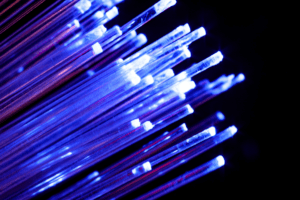
Fiber optics can be faster and more dependable than other options.
As your business grows and expands across multiple buildings, your employees rely on a fast, reliable network to stay connected. Whether transferring files between offices or accessing cloud applications, keeping everything running smoothly is crucial.
As businesses scale, traditional copper cables quickly show their limitations. That’s where fiber optic cabling comes in, connecting your buildings over long distances while turbocharging your entire network.
Copper vs. Coax vs. Fiber: Understanding the Basics
-
- Copper (e.g., Cat6 Ethernet):
Copper cables transmit data using electrical signals. They’re often limited to about 300 feet before the signal degrades. To cover more distance, you must install multiple switches at intervals — each switch effectively resets the signal to keep it strong. However, extra switches can increase costs, add complexity, and introduce delays with each hop.
-
- Coax (e.g., Cable TV lines):
In certain situations, coax cables handle longer distances (up to 1,640 feet) than standard copper Ethernet without as many switches. However, they don’t match fiber’s capability to handle ultra-long distances and high-speed data transmission.
-
- Fiber Optics:
Fiber uses light pulses to transmit information, allowing data to travel faster and farther without signal loss. This makes it more resistant to interference, reliable, and capable of delivering high bandwidth across large distances. According to the Fiber Optic Association, fiber optics can transmit data over distances up to 24 miles — a feat copper cables simply can’t match.
Going the Distance
Fiber optic cabling means uninterrupted, high-speed connectivity for businesses managing multiple locations.
Take, for example, an organization with three office buildings spread across a large campus. With traditional copper cables, the signal would degrade as it travels beyond the recommended distance of 100 meters. By running fiber optic cables between buildings, businesses ensure that data flows seamlessly without worrying about lag or loss of speed. Fiber optics can easily carry data from one building to another, even if those buildings are miles apart.
Beyond distance, fiber also excels in speed and overall reliability: “Fiber optics make data flow faster and more efficiently, helping businesses avoid bottlenecks that slow productivity,” said Adam Preusler, IT Manager at Kustura Technologies, an expert IT Service Company in Jacksonville FL. “In an age when cloud computing and large file transfers are the norm, this is an important advantage.”
Connecting Switches for Higher Bandwidth
Imagine a business with several network switches spread across different floors or buildings. Each switch helps distribute data to computers, printers, and phones. As more switches are added to handle increased data traffic, the potential for network bottlenecks grows. That’s because traditional copper cables can’t always keep up with the bandwidth demands of multiple switches, especially in a busy, data-heavy environment.
This is another area where fiber optic technology delivers an undeniable advantage. When businesses use fiber optics to connect network switches, they unlock the potential for higher bandwidth, allowing data to flow more efficiently throughout the entire system. Fiber optic connections between switches offer significantly more bandwidth than copper cables, ensuring smooth communication even as the network expands.
The Roadmap to Installation
Installing fiber optic cabling requires careful planning and consideration. While the initial investment may be higher than copper cables, the long-term benefits — increased speed, reliability, and future-proofing against growing data demands — often justify the cost.
Before proceeding with installation, businesses should evaluate the following key factors:
-
- Network Design:
Review your network’s layout to identify the most efficient paths for cable installation.
-
- Budget:
Consider the price of materials, labor, and infrastructure modifications. A well-planned design can help minimize expenses and reduce installation time.
-
- Professional Expertise:
Engage experienced professionals in IT Solutions Jacksonville FL, or Digital IT Solutions Gainesville FL, for a successful installation. They can recommend the correct type of fiber, handle proper termination, and ensure that all industry standards are met, leading to a seamless and efficient setup.
Future-Proofing Your Network
Businesses need a network that can keep pace with rapidly changing technology. Fiber optic cabling isn’t just a solution for today; it’s an investment in the future. According to BIS Research, the fiber optic cable market, valued at $14.61 billion in 2022, is projected to reach $43.02 billion by 2032.
By choosing fiber optics now, businesses can extend the lives of their networks, ensuring they’ll be ready for whatever technological advancements lie ahead — without the need for constant upgrades or network disruptions.
Next Steps
Are you ready to upgrade your network? Contact Kustura Technologies, a leader in IT Support Services Jacksonville FL and Managed IT Solutions Jacksonville FL, at info@kustura.com to explore how fiber optic cabling can optimize performance and prepare your network for the future.
